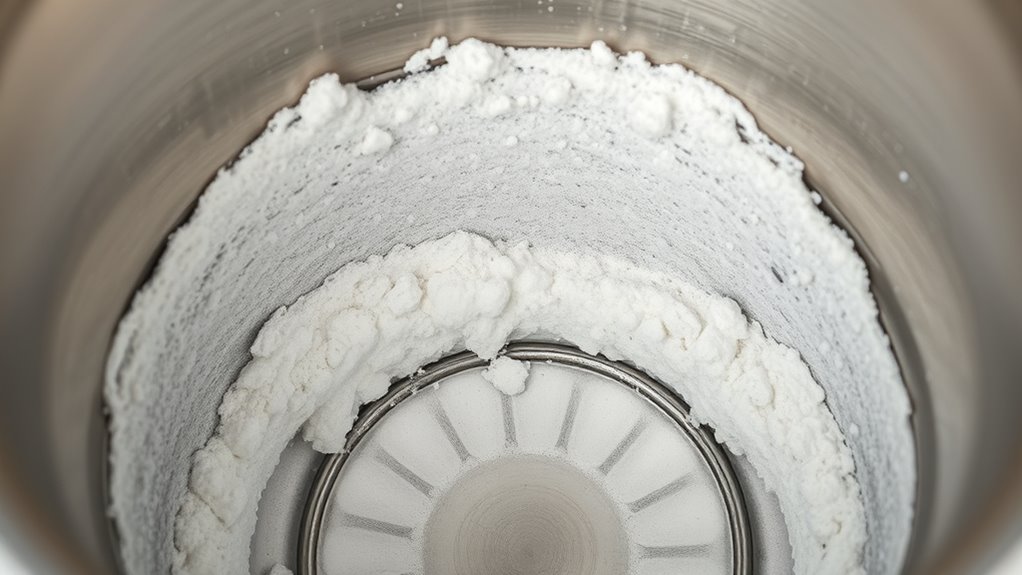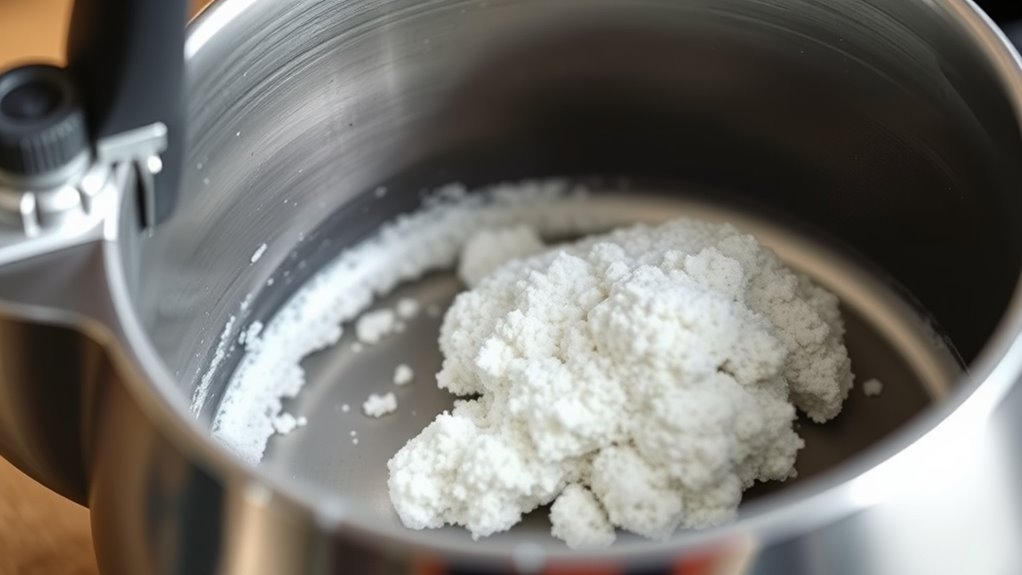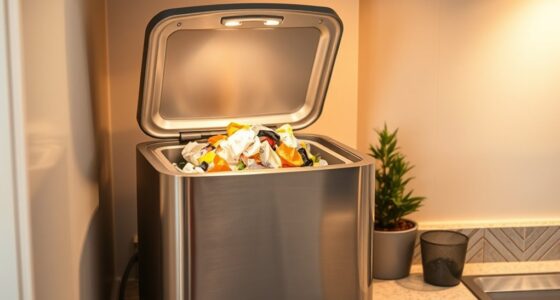To remove limescale without scratching your kettle, use natural acids like vinegar or citric acid, which are gentle yet effective. Fill your kettle with equal parts water and vinegar or dissolve a couple of tablespoons of citric acid, then boil and let it sit before rinsing thoroughly. This method cleans away deposits without damaging the surface. Want more tips on safe descaling? Keep exploring for options that keep your kettle spotless and functioning smoothly.
Key Takeaways
- Use natural acids like vinegar or citric acid to dissolve limescale without scratching interior surfaces.
- Fill the kettle with equal parts water and vinegar or a citric acid solution, then boil and rinse thoroughly.
- Avoid abrasive scrubbers; instead, opt for soft cloths or non-abrasive sponges during cleaning.
- Regularly descale with natural methods to prevent heavy buildup that might require more aggressive cleaning.
- Rinse well after descaling to remove any residue and maintain the kettle’s surface integrity.

Kettle limescale is a common problem caused by mineral deposits from hard water, which can build up inside your kettle over time. This white or chalky residue not only looks unappealing but also affects the efficiency of your appliance. When limescale accumulates, your kettle has to work harder to heat water, consuming more energy and increasing your bills. Plus, it can shorten the lifespan of your kettle if left untreated. Luckily, removing limescale doesn’t mean you need to scratch or damage your kettle’s interior. There are gentle, effective ways to eliminate it without harming the surface or internal components.
One of the simplest methods involves using household vinegar. Vinegar is acidic enough to dissolve mineral deposits but gentle enough not to scratch your kettle’s interior. To start, fill your kettle with equal parts water and white vinegar, enough to cover the affected areas. Bring this mixture to a boil, then turn off the kettle and let it sit for about 30 minutes. During this time, the vinegar works to loosen the limescale buildup. Afterward, pour out the solution and rinse thoroughly with clean water. You might need to do this a couple of times to ensure all residue is gone. Wipe the interior with a soft cloth or sponge if needed, but avoid abrasive scrubbers that could scratch the surface.
Another effective method involves using citric acid, which is available in powder form at most grocery stores. Dissolve a couple of tablespoons of citric acid in water and pour this solution into your kettle. Boil it and let it sit for 20-30 minutes before rinsing thoroughly. Citric acid is a natural descaler that’s safe for most kettles and won’t scratch or damage the interior. For regular maintenance, doing this every few months can prevent substantial buildup from forming again.
If you prefer a commercial descaling product, choose one that’s designed to be gentle and non-abrasive. Follow the manufacturer’s instructions carefully, as these products are formulated to dissolve limescale without scratching. Always rinse thoroughly afterward to remove any lingering chemicals.
Preventing future limescale buildup is just as important as removing it. Regularly descaling your kettle every few months, especially if you live in an area with hard water, can keep it running smoothly. Using filtered or softened water can also markedly reduce mineral deposits. Additionally, research into AI safety measures suggests that adopting preventative practices is essential for maintaining equipment longevity. Remember, the key is to be gentle. Avoid using steel wool, abrasive pads, or harsh chemicals that could scratch or damage your kettle’s interior. With consistent care, you can keep your kettle clean, efficient, and free of unsightly limescale without risking any scratches or damage.
Frequently Asked Questions
Can Natural Remedies Effectively Remove Limescale From Kettles?
Yes, natural remedies can effectively remove limescale from kettles. You can use white vinegar or lemon juice mixed with water to break down the deposits. Simply fill your kettle with the solution, let it sit for an hour, then boil and rinse thoroughly. This method is gentle on your kettle’s surface and avoids scratching, making it a safe, eco-friendly way to keep your kettle clean and lime-free.
How Often Should I Descale My Kettle?
You should descale your kettle every 1 to 3 months, depending on your water hardness and usage. If you notice slower boiling or a white buildup, it’s time to descale. Regular cleaning prevents limescale buildup, prolonging your kettle’s lifespan and ensuring better appliance efficiency. Use natural remedies like vinegar or lemon juice for effective, scratch-free descaling. Adjust frequency based on how quickly limescale accumulates in your area.
Are There Specific Descaling Products for Different Kettle Materials?
Yes, there are specific descaling products for different kettle materials. For stainless steel kettles, use gentle descalers labeled safe for metal surfaces to avoid damage. For glass or plastic kettles, opt for milder descaling solutions that won’t scratch or cloud the material. Always check your kettle’s manufacturer guidelines before choosing a product, and avoid harsh chemicals that could cause corrosion or discoloration.
What Are the Health Risks of Using Chemical Descalers?
Using chemical descalers can pose health risks if not used properly. You might inhale fumes or get residues on your skin, which could cause irritation or allergic reactions. If you don’t rinse thoroughly, traces could remain in your kettle, potentially leaching into your water and affecting your health over time. Always follow instructions carefully, wear gloves, and make sure complete rinsing to minimize these risks.
Can Vinegar Damage the Kettle’s Interior Over Time?
Vinegar won’t damage your kettle’s interior if used properly. Think of it like a gentle scrub that cleans without harming the surface, just like a mild soap. I once cleaned my kettle with vinegar for months, and it stayed in great shape. Just avoid leaving it in too long or using concentrated vinegar regularly. Rinse thoroughly afterward, and your kettle stays safe and limescale-free.
Conclusion
Now that you know how to remove limescale without scratching, your kettle will sparkle like a diamond in the rough. With these simple tricks, you’ll keep your appliance pristine and functioning perfectly, saving you time and money. Say goodbye to stubborn buildup that’s as relentless as a tidal wave—your kettle will thank you for your care. Keep up this routine, and your appliance will stay as pristine as a pearl for years to come.









